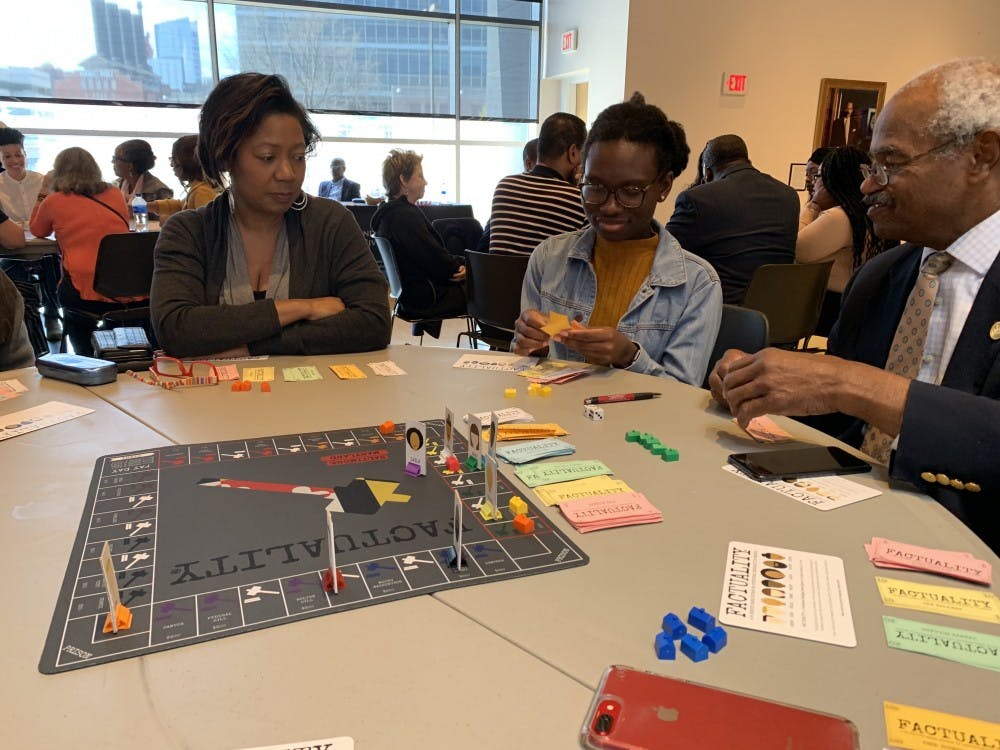The Reginald F. Lewis Museum and the Maryland Commission on Civil Rights co-hosted an event entitled “Baltimore After Freddie Gray” on Saturday. The event reflected how the 2015 Baltimore Uprising drew attention to systemic issues of racial inequality within the city, such as the implementation of zero-tolerance policing.
Freddie Gray, an unarmed black Baltimore resident, passed away on April 12, 2015 after suffering a severe spinal cord injury while in police custody. Gray’s death led to a series of protests across the city, known as the Baltimore Uprising.
The event started with the board game Factuality. The game, created by Natalie Gillard, is intended to facilitate conversations about structural inequality in the U.S. Players choose characters from diverse backgrounds; the characters have advantages or disadvantages based on intersections of the characters’ race, gender, sexual orientation, faith and class.
Gillard stated that when she created the game, she sought to imitate the real-life experiences of diverse racial identities. She stated in an interview with The News-Letter that she thought the groups participating in the game benefited from the experience.
“I liked the diversity in this group, especially regarding age. It lends itself to different types of conversation for a game about Baltimore,” she said.
When playing, participants were asked to select whichever character was the least like themselves. Gillard stated that she wanted everyone to experience limitations and advantages different from their real lives.
Hester Darcy, who attended the event, works as a consultant and tries to incorporate diversity, equity work and inclusion into the structure and culture of companies.
“The fact that this was a game was appealing and changed how we talked about [diversity and inclusion]. It made it lighter and a little easier for some,” Darcy said.
Sean Yoes, Baltimore Editor of the Afro-American Newspapers, discussed the events that followed Freddie Gray’s death. Some of the topics he covered included the U.S. Department of Justice’s report on the civil rights violations of the Baltimore Police Department (BPD), the corruption in the Gun Trace Task Force and the death of Baltimore homicide detective Sean Suiter.
He explained that these events prompted him to compile a book of commentary on these events and their aftermath, which brought together 50 different narratives on how Baltimoreans’ lives had changed.
“We have some of the most resilient people in this city, so I’m hopeful about this city. But at what point does your hope begin to wane? I would argue that we’re at that point,” he said.
Yoes discussed the history of racial divide in the city and how it built the foundation for present-day issues of race.
“How many of you know that Baltimore invented segregation in the United States? In 1911, the first legal ordinance of housing segregation was crafted here in Baltimore. One of the first stories I ever wrote was about this University of Chicago study that classified Baltimore as one of the most segregated cities in the U.S. It’s so segregated, it was given the classification of hyper-segregated,” Yoes said.
Yoes argued that President Bill Clinton’s 1994 Crime Bill led to the establishment of zero-tolerance policing in Baltimore. Together, these initiatives created an environment increasingly hostile to black people and the pervasive idea that law enforcement was untrustworthy.
Consequently, citizens preferred to enact their own justice rather than reporting violent crime to the police. Yoes explained that when people are in gangs or other unsafe situations, they tend to react proactively with violence, furthering an aggressive climate.
“We are out of time. Baltimore is out of time. We must collectively decide that it is time to do something. We must be in the process of implementing plans,” he said.
The six officers implicated in Gray’s death were suspended with pay, and Baltimore City State’s Attorney filed charges against them. The charges claimed that the police had broken the law and no crime had been committed by Gray. Yoes connected Gray’s death to a significant change in how Baltimoreans viewed their relationship with the police.
“Freddie Gray just brought everything to light. Everything is out of the dark,” he said.
Traka Lopez, a graduate student at Morgan State University, attended the event as part of an assignment and reflected on how it deepened her understanding of the racial dynamics of Baltimore.
“We had to be engaged in education and programming in a museum space. Throughout the duration of the program, I learned a lot about Baltimore and all the hindrances that come with different racial identities,” she said.
Terry Taylor, who organized the programming for the event, expressed his happiness with how the event turned out.
“It was a different way of looking at race, inequality and marginalized groups. A museum should be a safe place for people to have conversation and dialogue about race. The discussion today felt safer and more informal,” she said.





